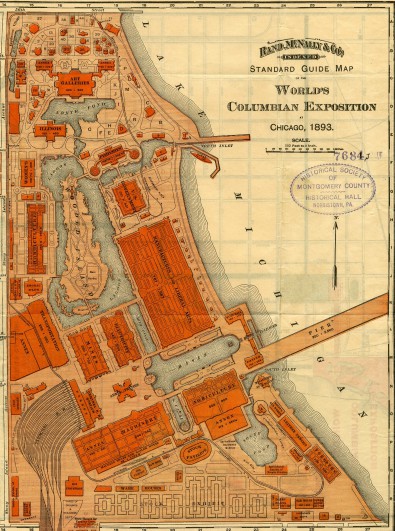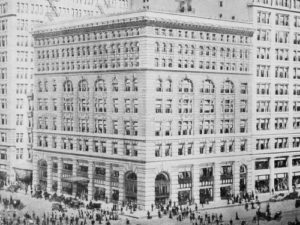By Pris Mims, Class of 2000
As we give our tours this year, 2018, let’s take the opportunity to recognize the noteworthy anniversaries of the 1893 Fair and these important buildings. Here are a few tidbits regarding each.
1893 (125 years)
• The World’s Columbian Exposition
• Art Institute of Chicago’s Robert Allerton Building
• Chicago Athletic Association (Hotel)
• Congress Plaza Hotel & Convention Center
• Macy’s at Wabash and Washington (“the Marshall Field’s Annex”)
• Monadnock (south addition)
1968 (50 years)
• Lake Point Tower
• Seventeenth Church of Christ Scientist
World’s Columbian Exposition
 The right to hold a fair celebrating the 400th anniversary of Columbus’s discovery of America was awarded to Chicago by legislation passed by Congress and signed into law by President Benjamin Harrison in 1890. But before the end of the year, it became apparent that such a major undertaking would not be ready by 1892. The official explanation was that this allowed local celebrations to take place in the actual anniversary year. Opening day of the World’s Fair was May 1, 1893. Closing ceremonies, six months later on October 31, were muted because of the assassination of Mayor Carter Harrison three days earlier. As many of us recite on tours, while Chicago had a population of about 1.5 million, 27 million people went through the turnstiles. The Fair made a profit of about $2 million that was distributed to the stockholders.
The right to hold a fair celebrating the 400th anniversary of Columbus’s discovery of America was awarded to Chicago by legislation passed by Congress and signed into law by President Benjamin Harrison in 1890. But before the end of the year, it became apparent that such a major undertaking would not be ready by 1892. The official explanation was that this allowed local celebrations to take place in the actual anniversary year. Opening day of the World’s Fair was May 1, 1893. Closing ceremonies, six months later on October 31, were muted because of the assassination of Mayor Carter Harrison three days earlier. As many of us recite on tours, while Chicago had a population of about 1.5 million, 27 million people went through the turnstiles. The Fair made a profit of about $2 million that was distributed to the stockholders.
But of course, it is the legacy of the Fair that is important. To learn more about the Fair and its legacy, take any or all of the following CAF tours: Devil and the White City, Food and Architecture, Historic Treasures of Culture & Commerce (soon to be Historic Treasures of Chicago’s Golden Age), and White City Revisited.
Art Institute of Chicago, the Robert Allerton Building
Designed by Shepley, Rutan, & Coolidge, the original building of what is now the Art Institute was built to house programs by the World’s Congresses Auxiliary as part of the World’s Fair, and then serve as the Art Institute following the Fair. The building was constructed in Lake Park (now Grant Park) despite the “forever free and clear” restriction because a Chicago ordinance allowed buildings in the park with the permission of the adjoining landowners. However, the building was restricted to 400 feet along Michigan Avenue.
Currently, the building is featured on Historic Skyscrapers, Chicago Masterworks, Evolution of the Skyscraper, Tiffany Treasures, and Historic Treasures of Culture & Commerce.
Chicago Athletic Association (Hotel)
The exclusive men’s club was founded in 1890 and its original members included Marshall Field, Cyrus McCormick, and William Wrigley. The design by Henry Ives Cobb was patterned after the Doge’s Palace in Venice. Today it has been beautifully restored and converted to a hotel.
It is featured as its own building tour, as well as Hotel Boom, and will soon be included on the Historic Treasures of Chicago’s Golden Age tour.
Congress Plaza Hotel & Convention Center
The north tower of the present building was designed by Clinton J. Warren with Adler & Sullivan as consulting architects. It opened in 1893 as the Auditorium Annex and was connected to the Auditorium Hotel by an underground passageway known as “Peacock’s Alley.” While the Annex had an underlying metal frame, it was deliberately designed to complement the Adler & Sullivan building across the street. It did have one major advantage over the original hotel: en suite bathrooms for each guest room.
Macy’s at Washington & Wabash (the Marshall Field’s Annex)
 Up until last year, relying on the AIA Guide to Chicago, docents used 1892 as the date for the building. In researching the opening day of the building, Delta Greene, tour director for Macy’s on State Street, found that the application for landmark status for the entire complex stated that the Annex opened in 1893 during the World’s Fair. This was confirmed by articles in the Chicago Tribune in 1892 and 1893. As docents who give Historic Treasures of Culture & Commerce (soon to be Historic Treasure of Chicago’s Golden Age) and the Macy’s building tour know, the style of this building by Charles Atwood of D.H. Burnham & Co. is said to be “Spanish Renaissance” in keeping with the theme of the Fair, honoring the discovery of America by Columbus and financed by the King and Queen of Spain.
Up until last year, relying on the AIA Guide to Chicago, docents used 1892 as the date for the building. In researching the opening day of the building, Delta Greene, tour director for Macy’s on State Street, found that the application for landmark status for the entire complex stated that the Annex opened in 1893 during the World’s Fair. This was confirmed by articles in the Chicago Tribune in 1892 and 1893. As docents who give Historic Treasures of Culture & Commerce (soon to be Historic Treasure of Chicago’s Golden Age) and the Macy’s building tour know, the style of this building by Charles Atwood of D.H. Burnham & Co. is said to be “Spanish Renaissance” in keeping with the theme of the Fair, honoring the discovery of America by Columbus and financed by the King and Queen of Spain.
The Monadnock, south addition
Unlike the 1891 north portion with its masonry load-bearing walls by Burnham & Root, the south portion designed by Holabird & Roche is an example of the Chicago Commercial skyscraper with an underlying metal frame. Learn more about the entire building on the Historic Skyscrapers and the Monadnock Building tours.
And let’s not forget two buildings celebrating their 50th birthdays …
Lakepoint Tower
Hard to believe that this iconic curving mid-century modern building by Schipporeit & Heinrich turns 50 this year. The building that shouldn’t be there (because it is east of Lakeshore Drive) is featured on the River Cruise.
Seventeenth Church of Christ, Scientist

Designed by Harry Wees to fit the needs and doctrine of the congregation, this notable building also fulfills the architect’s purpose that it would stand out among the surrounding high rises on this visible corner of Wacker and South Water. You can learn more about the building on the new Chicago Modern tour, as well as on the Sacred Spaces in Downtown Chicago tour where you can see the interior.
Sources:
(1) The Chicago World’s Fair of 1893, A photographic Record, text by Stanley Appelbaum, Dover Publications, Inc., 1980.
(2) The CAF “Modern Wing Tour Manual.”
(3) http://www.congressplazahotel.com/history-en.html


Nice article, Pris. Many thanks.
Pris — Thanks for putting this together. Helpful in rethinking Treasures Tour.